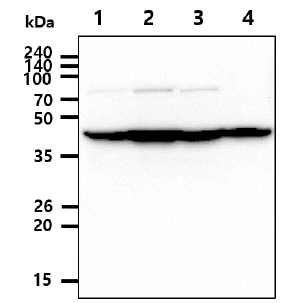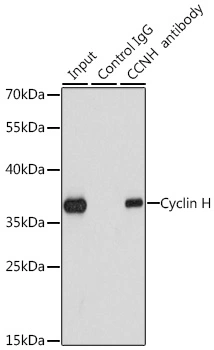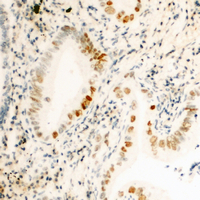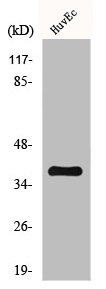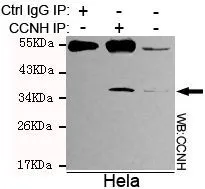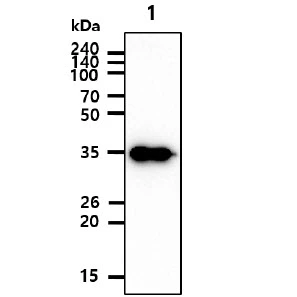
WB analysis of Recombinant Human Cyclin H protein using GTX57623 Cyclin H antibody. Loading : 25 ng Dilution : 1:1000
Cyclin H antibody [AT3G6]
GTX57623
ApplicationsWestern Blot
Product group Antibodies
TargetCCNH
Overview
- SupplierGeneTex
- Product NameCyclin H antibody [AT3G6]
- Delivery Days Customer9
- Application Supplier NoteWB: Recommended starting dilution is 1:1000.. *Optimal dilutions/concentrations should be determined by the researcher.Not tested in other applications.
- ApplicationsWestern Blot
- CertificationResearch Use Only
- ClonalityMonoclonal
- Clone IDAT3G6
- Concentration1 mg/ml
- ConjugateUnconjugated
- Gene ID902
- Target nameCCNH
- Target descriptioncyclin H
- Target synonymsCAK, CycH, p34, p37, cyclin-H, CAK complex subunit, CDK-activating kinase complex subunit, MO15-associated protein, cyclin-dependent kinase-activating kinase complex subunit
- HostMouse
- IsotypeIgG2b
- Protein IDP51946
- Protein NameCyclin-H
- Scientific DescriptionThe protein encoded by this gene belongs to the highly conserved cyclin family, whose members are characterized by a dramatic periodicity in protein abundance through the cell cycle. Cyclins function as regulators of CDK kinases. Different cyclins exhibit distinct expression and degradation patterns which contribute to the temporal coordination of each mitotic event. This cyclin forms a complex with CDK7 kinase and ring finger protein MAT1. The kinase complex is able to phosphorylate CDK2 and CDC2 kinases, thus functions as a CDK-activating kinase (CAK). This cyclin and its kinase partner are components of TFIIH, as well as RNA polymerase II protein complexes. They participate in two different transcriptional regulation processes, suggesting an important link between basal transcription control and the cell cycle machinery. A pseudogene of this gene is found on chromosome 4. Alternate splicing results in multiple transcript variants.[provided by RefSeq, Nov 2010]
- Storage Instruction-20°C or -80°C,2°C to 8°C
- UNSPSC12352203

